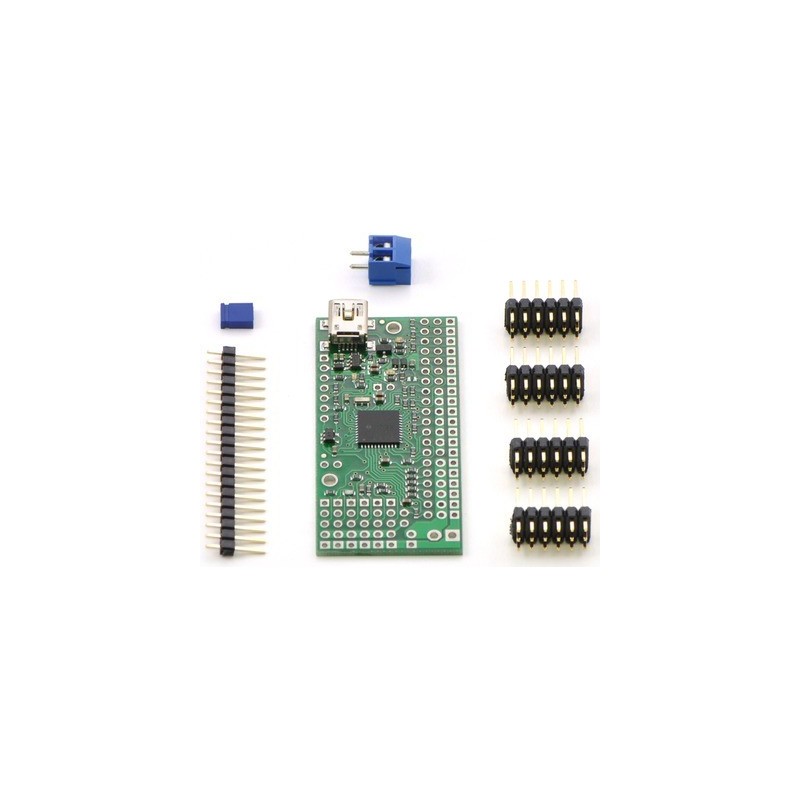



zł167.42 tax excl.
Mini Maestro 24 (kit) is a flexible controller for advanced applications with multiple servos, offering sophisticated motion control, signal reading, and autonomous operation capabilities. It is ideal for use in robotics, animatronics, and embedded systems as a precise controller and input/output expander.
The Mini Maestro 24 in kit version is the most advanced servo controller in the Maestro series, featuring 24 configurable channels with high pulse generation precision (0.25 µs) and independent speed and acceleration control for each channel. It supports USB, TTL UART, and autonomous modes thanks to a built-in script interpreter and 8 KB of memory. Channels can also be used as analog inputs, digital inputs, or digital outputs, making it a flexible I/O expander. The self-assembly version includes goldpin connectors for soldering. The device can be powered via USB or an external 5–16 V power source.
Manufacturer BTC Korporacja sp. z o. o. Lwowska 5 05-120 Legionowo Poland sprzedaz@kamami.pl 22 767 36 20
Responsible person BTC Korporacja sp. z o. o. Lwowska 5 05-120 Legionowo Poland sprzedaz@kamami.pl 22 767 36 20
Cable with USB plugs type A and mini-USB type B, cable with a length of 1.8 m
No product available!
Mini Maestro 24 in assembled version provides full functionality for controlling 24 servos, with the option to expand with analog and digital inputs. It is ideal for complex robotic applications, interactive installations, and animatronic projects where precise and automated management of multiple channels is required.
No product available!
DFRobot DRI0057 board enables control of complex servo systems using USB or UART interfaces and provides full bidirectional communication with servos. Designed for advanced robotics and applications requiring precise synchronization of multiple drives.
No product available!
This Kit with fully-dedicated PWM driver chip handles all the motor and speed controls over I2C. Only two data pins (SDA & SCL in addition to the power pins GND & 5V) are required to drive the multiple motors; you can also connect any other I2C devices or shields to the same pins. This makes it drop-in compatible with any Arduino, such as the Uno, Due, Leonardo and Mega R3. Adafruit 1438
The PCA9685 servo driver module is dedicated to micro: bit educational boards. It allows you to control 16 PWM channels. SB Components 09183
No product available!
Module with 8-channel servo driver. It allows you to control the speed of movement and the initial position of the servo. Cytron SC08A
Mini Maestro 12 in kit version is a multifunctional controller for controlling servos, reading sensors, and executing motion sequences without a computer. Excellent for use in robotics, animatronics, and interactive systems, it enables flexible motion control and peripheral management from a PC or microcontroller.
No product available!
Pololu Micro Maestro 1350 is a compact, versatile servo controller with a USB interface and autonomous operation capability, designed for use in robotics, animatronics, and control systems based on PCs or microcontrollers. Thanks to its flexible channel configuration, it can also be used as a sensor interface and I/O expander.
Compact controller with XIAO ESP32-C3 module, enabling precise control of ST/SC servos via UART interface. Thanks to its solid construction and 5-12 V power supply, it allows simultaneous control of multiple servos, which is suitable for humanoid robots, hexapods and robotic arms. Arduino IDE support, open architecture and easy assembly make it a great tool for education, prototyping and advanced robotic projects. Seeed Studio 114993612
Mini Maestro 24 in assembled version provides full functionality for controlling 24 servos, with the option to expand with analog and digital inputs. It is ideal for complex robotic applications, interactive installations, and animatronic projects where precise and automated management of multiple channels is required.
No product available!
Adafruit 16-Channel PWM / Servo HAT for Raspberry Pi - Mini Kit (Adafruit 2327)
The expansion module is designed to work with the micro:bit educational board. It can control 3 servos and 2 DC motors. Waveshare Motor Driver for micro:bit
With this smart arduino digital servo shield and Dynamixel AX series servos, It\'s quite easy for you to drive multi servos with daisy chain connection with an Arduino board such as Arduino Uno, and build your robotic dog, hexapod with powerful servos. DRI0027
No product available!
Servo control module. The operating parameters are configured by means of potentiometers placed on the board. SparkFun WIG-13118
No product available!

Mini Maestro 24 (kit) is a flexible controller for advanced applications with multiple servos, offering sophisticated motion control, signal reading, and autonomous operation capabilities. It is ideal for use in robotics, animatronics, and embedded systems as a precise controller and input/output expander.
